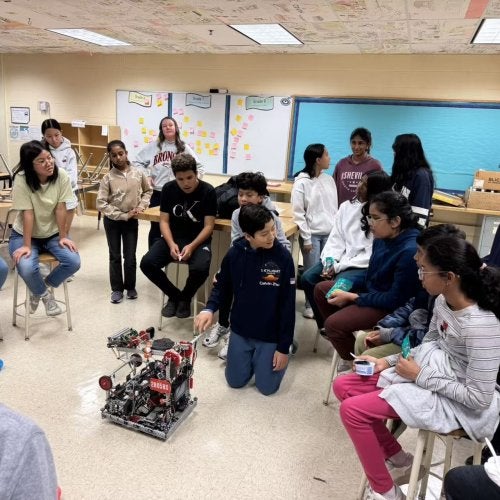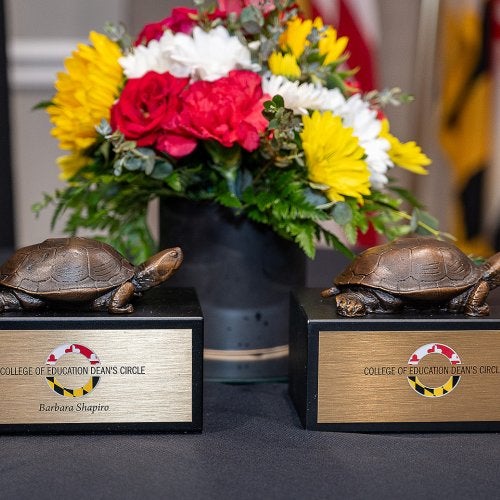
With the November election quickly approaching, heated political rhetoric and contentious debates have underscored the challenges of discussing diverse viewpoints in today’s polarized climate. Now more than ever, schools and communities are engaged in efforts to teach youth how to talk across political differences.
Recognizing the importance of equipping University of Maryland students, faculty and staff with the skills to engage in conversations around complex issues, the College of Education and the Office of Undergraduate Studies collaboratively launched the Intergroup Dialogue Training Center in Spring 2024. Under the leadership of co-Directors Jazmin Pichardo and Carlton Green, the center serves as a campuswide resource for dialogue facilitation training, curricular support and ongoing professional development. It will prepare faculty to implement new general education requirements that aim to help students understand the structural dimension of racism and develop skills for engaging across differences. The center’s goal is to foster a culture of meaningful, productive conversations across diverse sociocultural, political, ideological and disciplinary perspectives on campus.
“At a fundamental level, we all share a need and desire to belong–to feel that we matter to the communities we are a part of and that the issues that most affect us are worth acknowledging and addressing,” says Pichardo.
To help foster these types of productive conversations in the classroom, Pichardo and Green offer these five tips:
- Reframe conversations as opportunities for growth. Often, these types of discussions are labeled as “contentious,” “divisive” or “polarizing.” Green, who brings a counseling psychology background to diversity dialogues, explains that these terms imply a goal of achieving harmony or consensus, which can result in conversations that suppress or diminish dissenting or diverse viewpoints. Instead, he suggests framing these discussions as “necessary” and “constructive.” This shift in perspective emphasizes fostering community and collaboration rather than seeking agreement. By viewing disagreements as opportunities for growth and understanding, students and faculty can facilitate more open, productive dialogues.
- Create a brave (not just safe) space. Cultivating environments where students feel both physically and emotionally secure is essential. Equally important is ensuring that students are comfortable sharing their perspectives. “In brave spaces, students are encouraged to question biases, challenge assumptions and engage in meaningful dialogue,” says Pichardo. “These spaces empower students to take risks, make mistakes and, most importantly, learn from one another.”
To establish brave spaces, cocreate discussion norms, build trust and openly define what bravery means for everyone involved. “Remember, conflict is inevitable in these conversations,” Pichardo notes. “It's crucial to work together to navigate these moments constructively.”
- Embrace and manage emotions. Fear is a powerful emotion and can sometimes play a role in our efforts to face and discuss disagreements. Instead of suppressing emotions, embrace them as important aspects of dialogue that help promote understanding and connection. “Identifying, naming, communicating and responding to one’s own–as well as others’–emotions are skills that help with navigating conflicts and communicating care to others,” says Green. He also emphasizes the importance of promoting empathy, which can help students connect with each other, understand their peers’ perspectives and experiences, and build mutual respect.
- Lean into first draft thinking. In educational settings, there’s often pressure to demonstrate competence and provide the correct answers. Pichardo and Green challenge that notion by embracing “first draft thinking.” “It’s OK to offer emerging ideas, perspectives or observations, even if they’re still being processed,” says Green. This mindset not only promotes a culture of curiosity and learning but also makes it easier for students to engage with diverse perspectives.
- Focus on collaborative solutions. “In dialogue, we are seeking to build relationships across differences in order to collaboratively solve problems,” says Pichardo. Encourage students to identify shared goals and explore how different perspectives can contribute to innovative solutions.
“A healthy democracy, or a healthy classroom, relies on the ability of its members to engage in constructive dialogue, even when they disagree,” says Pichardo. “Our past is rich with examples of leaders engaging in robust and thoughtful discourse from diverse viewpoints, and it is these very exchanges that continue to shape and sustain a democracy that strives to serve everyone.”



